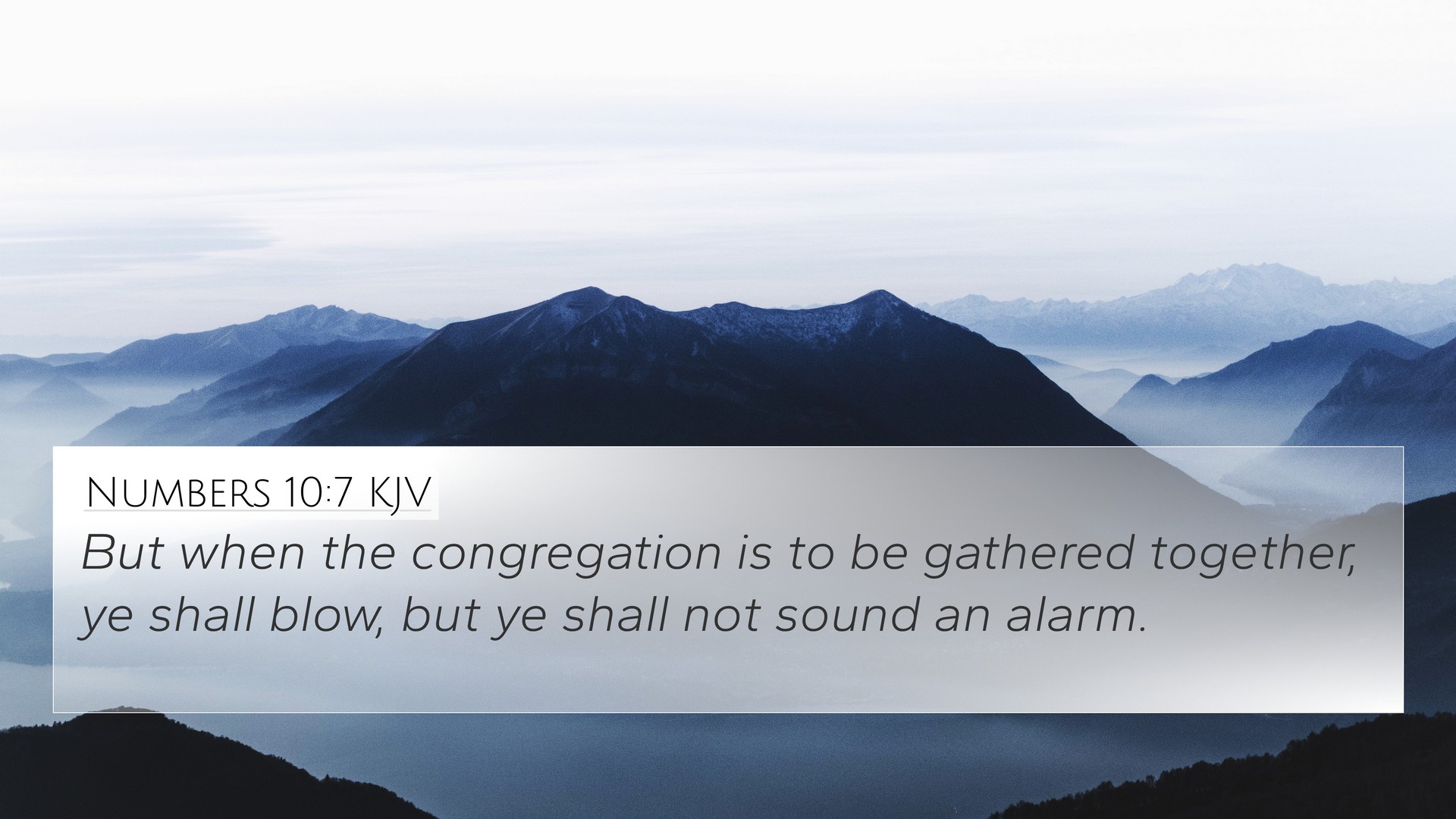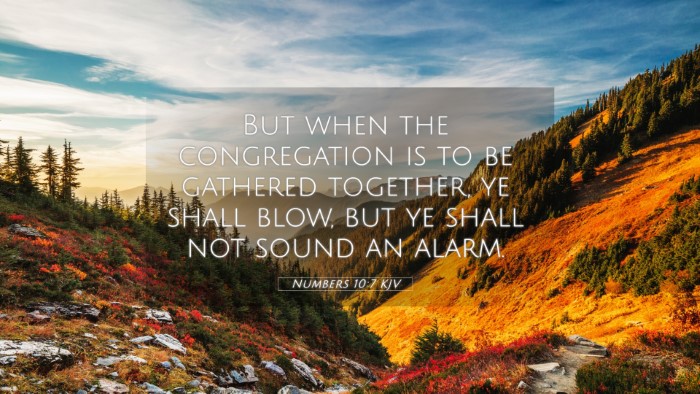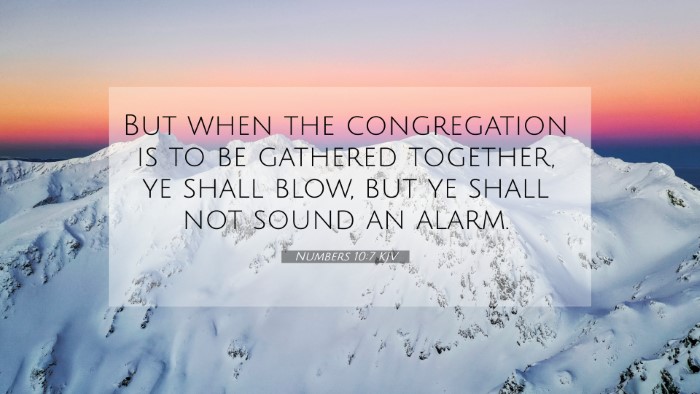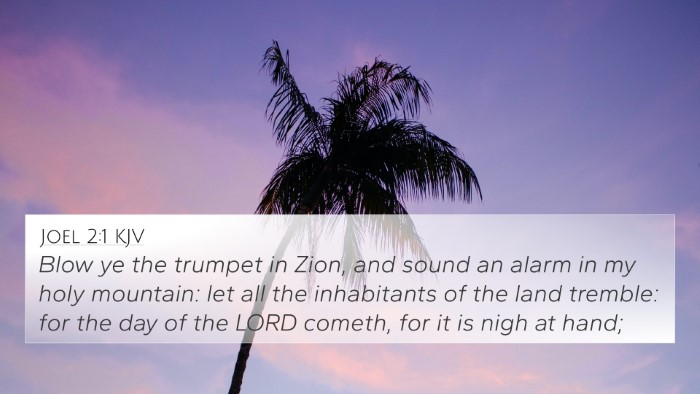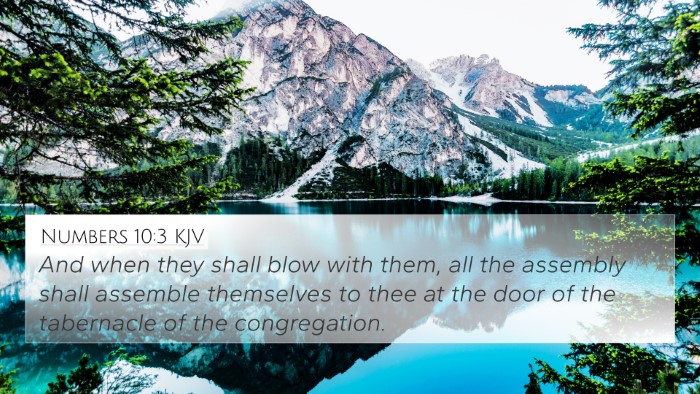Understanding Numbers 10:7
Verse: Numbers 10:7 - "But when the congregation is to be gathered together, ye shall blow, but ye shall not sound an alarm."
Summary of Meaning
Numbers 10:7 highlights the importance of proper communication within the congregation of Israel, particularly in the context of gathering for worship or significant events. This command emphasizes the distinction between various types of signals, indicating that while certain sounds are appropriate for calling the assembly together, they should not instill fear or alarm among the people. The practice of using trumpets to signal various events reflects God's order and structure in community worship.
Commentary Insights
Matthew Henry's Commentary
Matthew Henry notes the significance of the trumpet call as a divine ordinance, intended to foster unity and prepare the people for worship. Henry underscores that this specific use of the trumpet serves a constructive purpose, aiming to gather people rather than scare them. The sound of the trumpet symbolizes God's presence and the need for His people to respond accordingly. Importantly, this verse reflects the overarching theme of divine guidance in communal settings.
Albert Barnes' Notes
Albert Barnes elaborates on the practical application of the trumpet in gathering the people, stating that the command serves to regulate and facilitate orderly assembly. Barnes emphasizes the distinction between gathering calls and alarm signals, suggesting that while alarms might suggest urgency or preparation for conflict, the gatherings were meant for worship and fellowship. The trumpet's role is integral in teaching the community about God's order in their public worship.
Adam Clarke's Commentary
Adam Clarke provides insight into the cultural significance of trumpet calls and their role in establishing identity among the tribes of Israel. He notes that the sounds made by the trumpets during gatherings would evoke a sense of belonging and purpose among the people, reinforcing their collective identity as God’s chosen nation. Clarke highlights that this scripture provides a framework for understanding how to approach God with reverence and formality as a community.
Bible Cross References
To fully grasp the implications of Numbers 10:7, we can look at related scriptures that deepen our understanding:
- Exodus 19:16-19: This passage recounts the trumpet's use at Mount Sinai to signal God's presence and the people's preparation to meet the Lord.
- Leviticus 23:24: Discusses the calling of solemn assemblies, paralleling the theme of gathering the people for holy observances.
- Deuteronomy 10:7: References the movement of the people in their journey, emphasizing organized and divinely guided actions.
- Psalm 81:3: Instructs to blow the trumpet at the new moon, illustrating the tradition of sound as a means to signify holy gatherings.
- 1 Corinthians 14:33: Speaks about order in worship, relating to the intentionality behind communal gatherings.
- 2 Chronicles 5:12: Mentions musicians and singers who played with trumpets, paralleling the role of sound in worship.
- Isaiah 27:13: Forecasts a gathering of the people which ties into the motif of community and divine purpose.
Conclusion
The insights gleaned from Numbers 10:7 are profound, emphasizing the importance of order, purpose, and reverence in communal worship settings. By understanding how this verse connects with others, we find a richer tapestry of meaning that enhances our appreciation for the structured worship practices established in biblical times. This verse invites us to explore the tools for Bible cross-referencing, allowing us to see the intricate relationships between different Biblical texts and themes.
Thematic Connections
In exploring Numbers 10:7, we uncover significant thematic Bible verse connections that demonstrate how God instructs His people to maintain order in worship:
- Community and Worship: The idea of gathering together showcases the importance of worship in unity.
- Divine Order: This illustrates the structured approach God desires for His people when they meet in His name.
- Faith and Assurance: The absence of alarm signifies a peaceful gathering, showing God’s provision and care.
Related Topics and Studies
The study of Numbers 10:7 offers an opportunity to engage with various cross-referencing Bible study methods, tools for Bible cross-referencing, and Bible reference resources that enhance our understanding of the scriptural context. Furthermore, such insights can be particularly beneficial for sermon preparation, enabling deeper discussions on the role of sound and signal in biblical narratives.
Bringing together comparative Bible verse analysis, we can also identify links between the Old and New Testament that showcase continuity in God’s purposes for gathering His people. As we navigate these connections, we grow in our understanding of how biblical themes recur across different contexts and what that means for our present worship practices.
